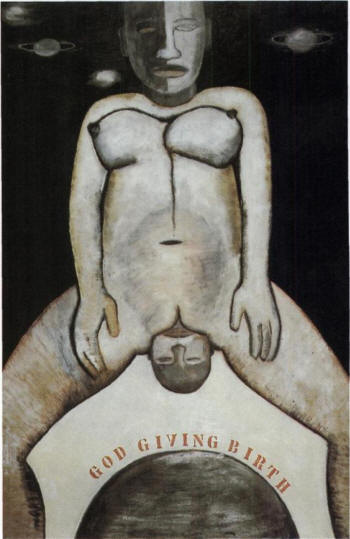Birth in the Iconic Feminist Artwork of Monica Sjoo
God Giving Birth, oil on canvas
Copyright 1968, Monica Sjoo. All Rights reserved.
Monica Sjoo (1938 – 2005) was a Swedish painter and writer who was also part of Anarcho-feminism and Ecofeminism. Her most famous painting, God Giving Birth, was also her most controversial. Sjoo wrote extensively about the painting and here are some of her words, some of which may also be helpful to pregnant women as they contemplate birth, empowerment, and going through labor. More of her writing on the painting be accessed here.
The painting was based on the natural home birth of my second son, Toivo in 1961, a birth that I experienced as a first initiation to the Great Mother who is both imminent and transcendent, both dark and light.
For the first time I experienced the enormous power of my woman’s body, both painful and cosmic and I “saw” in my mind’s eye great luminous masses of blackness and masses of radiant light coming and going. The Goddess of the Universe in her pure energy body. This birth changed my life and set me questioning the patriarchal culture we live in and its religions that deny the life-creating powers of the mothers and of the Greater Mother.
In ancient matrifocal cultures during the Neolithic, women gave birth in the sacred precincts of the Great Goddess where they were attended by shaman priestesses who were midwives, herbal healers and astrologers.
Birth was a sacrament and Vicki Noble once wrote that the original shaman is the birthing woman as she flies between the worlds bringing the spirits of the ancestors back into this realm, risking their own lives whilst doing so. We are spirit embodied.
I had given birth to my first son in a hospital in Stockholm and it had been a disaster for both of us. This home-birth, without medical and technical interventions, opened me up to the powers of the Great Mother.
In all patriarchies, women are de-sacralised and diminished and medicine and religion have been taken over by men who envy women’s creative sexual powers.
I wanted to create a painting that would express my emerging religious belief in the Great Mother as the Matrix of cosmic creation. I didn’t want Her to be a white woman. As a result of this work I was nearly taken to Court and my painting was censured many times during the 70s and 80s It was considered “ugly”, “obscene” and “blasphemous”. A modem day witch-hunt was carried out against me and my work. It was racist also. I didn’t know at the time I did the painting that the entire human race is thought to have originated from one or a handful of African women in the mists of time. This has been traced through the mitochondrial DNA which is only carried through the mothers/women. In 1968 there was also no women’s arts movement or a Goddess movement and I felt totally alone. I had a sense though that ancient women, who coincide with us in another time-space, were communicating with and through me. I was their medium and gateway into this world.
There are black stones or meteorites associated with Goddess sculptures worldwide such as Diana/Artemis at Ephesus. She is a Starmaiden and many legends tell of how the divine woman, such as Asht’art of the Phoenecians at Byblos in the Near East fell into a sacred lake from the sky as a flaming, whirling ball of light and fire. The “dark holes” in space might be entrances or gateways, the birth channel, to other universes. She is both the divine light and she is radiant and pulsating black light. She is infinite space. She is the She-serpent, Kundalini of invisible fire. I “saw” the radiant black light as my son was born and it changed my life forever.
Sjoo’s image is also helpful on a very practical level, which is that it shows a baby emerging from the body of a woman who stands and squats to give birth. The squatting position helps the labor woman use gravity during the birth process. The image also shows crowning of the baby, normalizing the act and helping the viewer to understand that the infant emerges from a woman’s body in this way and without difficulty.
More work by Monica Sjoo may be seen through this online gallery.
